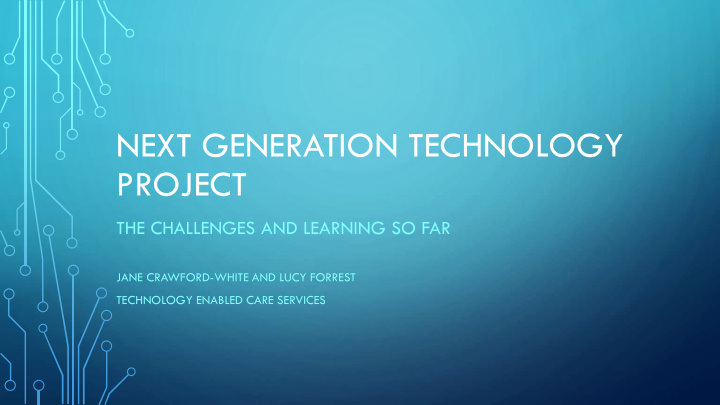



NEXT GENERATION TECHNOLOGY PROJECT THE CHALLENGES AND LEARNING SO FAR JANE CRAWFORD-WHITE AND LUCY FORREST TECHNOLOGY ENABLED CARE SERVICES
THE AMBITION • Trial of “intelligent” Lifelines • One year project • Compare with traditional Lifelines • Project funded by one off grant from NHS England, via a C&P CCG • Are they acceptable to Service Users and their informal carers • Can they demonstrate a return on investment
CARE@HOME PRO
CARE@HOME PLATFORM
UNUSUAL ACTIVITY DETECTED
WHY DO THE PROJECT? • Move telecare from being reactive to preventative • Testing the available machine learning systems • Making the most of the switch from analogue to digital • Enhancing the ASC preventative offering • Compatibility with APCP objectives
SUCCESSES • Health and social care services well engaged to make referrals • Training from Essence delivered for TEC and Call Centre staff for assessments, equipment installation and for 24/7 monitoring • Enhanced response • Investigative tool and guidance for ERS staff • Leaflet of prevention services for family responders • Strengthened 4 referral pathways to CPFT • Operational processes agreed for call centre staff for each type of activation
TECHNICAL ACHIEVEMENTS • New digital platform delivered and populated with customer data • Thorough testing between Care@Home equipment and call centre • All activations being received on primary server in call centre • Activations received: SOS, Unusual activity, for information eg ‘awake and well’ message, technical messaging eg switching networks, low battery, heartbeat • Smoke detectors were developed to instantly open voice communication • Secure communications: SCAIP protocol for SOS messaging, TLS2.1 for email transmission, VPN • Rectified loss of voice communication when call closed prematurely
LESSONS FROM PROCUREMENT • Competitive tendering process does not necessarily get the right outcomes when wanting to learn from trials • Detailed versus open tender specification • Fast changing market – lots of new products coming on stream but also companies going out of business or being bought out by another company • Project reliance on second contracts: Equipment supplier reliant on manufacturer, call centre reliant on call centre platform supplier. All 5 providers needed on the weekly technical conference calls • Very small market of telecare call centre platform suppliers, most not fully digitally compliant with both open APIs and following recognised protocols • Telecare equipment suppliers trying to protect their market share, incompatibility of hubs with peripherals
LEARNING TO DATE • The complexity of the technical integration. Need for involvement of TSA. • Time needed to complete the testing: sand pit, live environment test kits, older person willing to test and feedback • Development time was at all partners own expense. • The standard Pro pack not fully culturally relevant – houses vs apartments • Presentation of activity and activations data can be by SMS, email, app and user interface login. Flexibility useful for informal carers but not for the call centre staff who need it all presented on their call centre software
LEARNING TO DATE 2 • Being one of the first local authorities to do end to end digital telecare • Maintaining motivation of all providers to deliver outcomes, takes time to pinpoint faults and rectify. • The machine learning may not be suitable for people who self neglect – learns increasing levels of tolerance before threshold reached • Understanding the false positive activations. Machine learning did result in waking people up at 3.00am in the morning • Diversity of people that that have benefitted from Pro
EVALUATION • Being completed by independent company • Logic model developed from stakeholder interviews to determine the methodology of the evaluation • Undertaking semi structured interviews with Service Users and their informal carers • Comparing utilisation of social care and health care before and after installation and between intelligent and standard lifeline holders
Recommend
More recommend